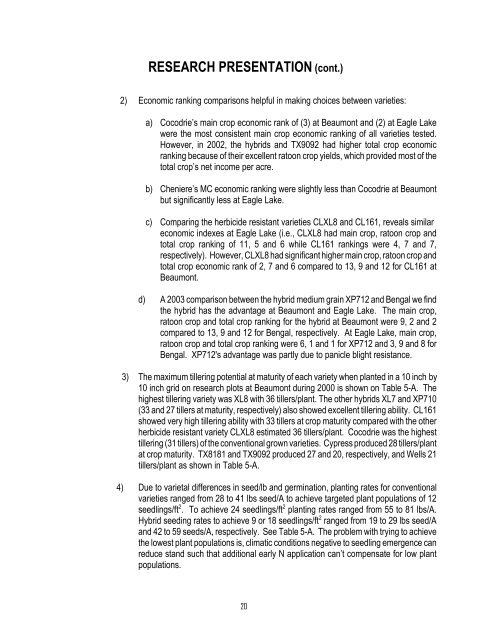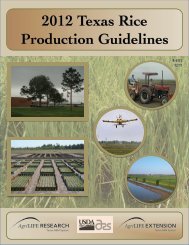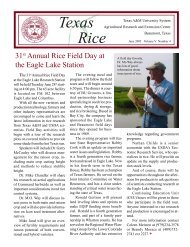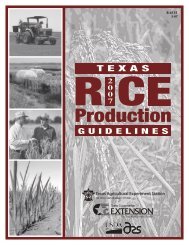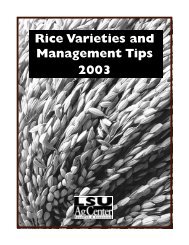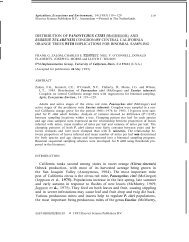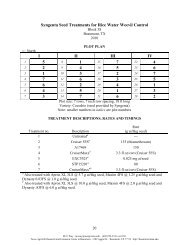Evaluating Potential Rice Varieties from University and Industry ...
Evaluating Potential Rice Varieties from University and Industry ...
Evaluating Potential Rice Varieties from University and Industry ...
Create successful ePaper yourself
Turn your PDF publications into a flip-book with our unique Google optimized e-Paper software.
RESEARCH PRESENTATION (cont.)<br />
2) Economic ranking comparisons helpful in making choices between varieties:<br />
a) Cocodrie’s main crop economic rank of (3) at Beaumont <strong>and</strong> (2) at Eagle Lake<br />
were the most consistent main crop economic ranking of all varieties tested.<br />
However, in 2002, the hybrids <strong>and</strong> TX9092 had higher total crop economic<br />
ranking because of their excellent ratoon crop yields, which provided most of the<br />
total crop’s net income per acre.<br />
b) Cheniere’s MC economic ranking were slightly less than Cocodrie at Beaumont<br />
but significantly less at Eagle Lake.<br />
c) Comparing the herbicide resistant varieties CLXL8 <strong>and</strong> CL161, reveals similar<br />
economic indexes at Eagle Lake (i.e., CLXL8 had main crop, ratoon crop <strong>and</strong><br />
total crop ranking of 11, 5 <strong>and</strong> 6 while CL161 rankings were 4, 7 <strong>and</strong> 7,<br />
respectively). However, CLXL8 had significant higher main crop, ratoon crop <strong>and</strong><br />
total crop economic rank of 2, 7 <strong>and</strong> 6 compared to 13, 9 <strong>and</strong> 12 for CL161 at<br />
Beaumont.<br />
d) A 2003 comparison between the hybrid medium grain XP712 <strong>and</strong> Bengal we find<br />
the hybrid has the advantage at Beaumont <strong>and</strong> Eagle Lake. The main crop,<br />
ratoon crop <strong>and</strong> total crop ranking for the hybrid at Beaumont were 9, 2 <strong>and</strong> 2<br />
compared to 13, 9 <strong>and</strong> 12 for Bengal, respectively. At Eagle Lake, main crop,<br />
ratoon crop <strong>and</strong> total crop ranking were 6, 1 <strong>and</strong> 1 for XP712 <strong>and</strong> 3, 9 <strong>and</strong> 8 for<br />
Bengal. XP712's advantage was partly due to panicle blight resistance.<br />
3) The maximum tillering potential at maturity of each variety when planted in a 10 inch by<br />
10 inch grid on research plots at Beaumont during 2000 is shown on Table 5-A. The<br />
highest tillering variety was XL8 with 36 tillers/plant. The other hybrids XL7 <strong>and</strong> XP710<br />
(33 <strong>and</strong> 27 tillers at maturity, respectively) also showed excellent tillering ability. CL161<br />
showed very high tillering ability with 33 tillers at crop maturity compared with the other<br />
herbicide resistant variety CLXL8 estimated 36 tillers/plant. Cocodrie was the highest<br />
tillering (31 tillers) of the conventional grown varieties. Cypress produced 28 tillers/plant<br />
at crop maturity. TX8181 <strong>and</strong> TX9092 produced 27 <strong>and</strong> 20, respectively, <strong>and</strong> Wells 21<br />
tillers/plant as shown in Table 5-A.<br />
4) Due to varietal differences in seed/lb <strong>and</strong> germination, planting rates for conventional<br />
varieties ranged <strong>from</strong> 28 to 41 lbs seed/A to achieve targeted plant populations of 12<br />
seedlings/ft 2 . To achieve 24 seedlings/ft 2 planting rates ranged <strong>from</strong> 55 to 81 lbs/A.<br />
Hybrid seeding rates to achieve 9 or 18 seedlings/ft 2 ranged <strong>from</strong> 19 to 29 lbs seed/A<br />
<strong>and</strong> 42 to 59 seeds/A, respectively. See Table 5-A. The problem with trying to achieve<br />
the lowest plant populations is, climatic conditions negative to seedling emergence can<br />
reduce st<strong>and</strong> such that additional early N application can’t compensate for low plant<br />
populations.<br />
20


